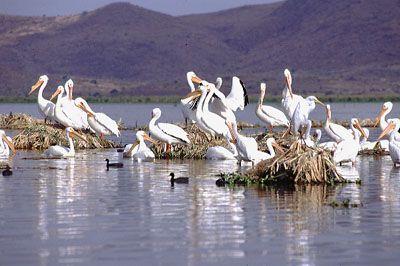Westwords

Granddaughter Kim couldn’t resist. Our slender, pert redhead scampered along the flatland toward the water. Thousands of white pelicans immediately got the message. After a second or three of awkward, cumbersome struggle, they got the heck out of there.
Aloft, these majestic birds are among God’s most handsome creations. Big. Graceful. Glorious. Soaring. Gliding. Circling.
And brave enough.
Soon the pelicans decided Kim was no serious threat. They returned to their parking places, not far from an island, not far from a marsh, not far from a small fleet of fishing boats near the town of Petatan, in the edge of Michoacan, not too far from our home in Jocotepec, Jalisco.
We claim this great flock of white pelicans as one of the spectacular winter attractions on rejuvenated Lake Chapala, in colorful, sunny southwest Mexico.
Like other snowbirds, white pelicans live somewhere else during spring, summer and football season. It seems impossible that birds with such heavy bodies can fly two thousand miles, stay in the air for hours at a time, and make it seem effortless. OK, they make rest stops and chow down.
White pelicans are highly social. Just as they live together on Lake Chapala, they hang close up north. They sun-bath, feed, sleep and nest in colonies. They are monogamous. They pair up in the spring and, working together, build a nest in four or five days. Short siestas, none of that Mexico mañana stuff.
They choose scattered locations in the great northern plains of the United States as homesites. Some go on to the prairie provinces of Canada, even though the exchange rate isn’t as good.
Chase Lake, between Jamestown and Bismarck, N.D., supposedly has the largest nesting colony. More than 20,000 show up each spring. That means 10,000 nests, two or three feet apart, just out of pecking range. So, how do adult couples know which nest is theirs? Nature is marvelous.
Pelican nests are usually grass, reeds and sticks, on the ground, often on an island if one is in the neighborhood. Mama pelicans produce two, three or four chalky white eggs. Both parents take turns sitting for a month. Both regurgitate fish and chips to feed the babies. Little birds stick their heads into the parents’ beaks and fight for their fair share. In three weeks or so, they grow enough to get around.
If you stumble upon nesting white pelicans, please do not disturb. International law protects them. Also, don’t try to feed them. You’ll go broke. White pelicans are among the world’s largest birds. Big ones weigh maybe 15 pounds. They eat a lot, three or four pounds of fish, salamanders, frogs and aquatic wigglers per day.
It’s really fun to watch the pelican show at Petatan. Unlike brown cousins, the white ones do not dive for dinner. They just float along on top of the water and use their big bills to scoop up a meal. The bill and pouch can hold a gallon or more of lake water plus assorted delicacies. The trick to neat dining is to drain off that mouthful of water and swallow the food.
Their fishing tactics bring back memories of cowboys herding cattle. The pelicans form a line, then tighten it into a half-circle, make a fuss with their wings, force small schooling fish into shallow areas and shovel ’em up and in.
Bird boosters would have us believe that white pelicans have very little effect on commercial fishing. Old-timers at Petatan aren’t so certain. People and pelicans don’t compete for larger fish that live in deeper water but all concerned like the same white fingerlings that swim near the surface.
Petatan still has boats and nets and long drying racks but the real fish factory, the processing plant, is out of business. Nobody says the pelicans did it. Nobody seems sure they didn’t.
It is reasonable to assume that Lake Chapala fishermen and the white pelicans know each other pretty well. Thanks to three decades of leg-banding study by the U.S. Fish and Wildlife Service, we are persuaded that the same birds that nest in Wisconsin and Minnesota year after year, for example, come to Mexico for the winter.
Wildlife people say that even without IMSS or Medicare, many pelicans live to enjoy their senior years. If they don’t get shot down or fly into power lines or get tangled in fishing nets, they might go beyond age 30.
Go out of your way to enjoy the white pelicans of Petatan. To these old eyes, they are a treasure and a treat.
